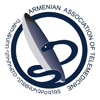 Among AATM's plans for strategic development of Healthcare ICT in Armenia special place is devoted to remote patients' monitoring and mobile (wireless) eHealth technologies. Importance of home telehealth lies in better management of chronic conditions and maintenance of health status in target groups of patients. Mobile telehealth (mHealth) emerges as one of the most promising areas of development in Health ICT.
Among AATM's plans for strategic development of Healthcare ICT in Armenia special place is devoted to remote patients' monitoring and mobile (wireless) eHealth technologies. Importance of home telehealth lies in better management of chronic conditions and maintenance of health status in target groups of patients. Mobile telehealth (mHealth) emerges as one of the most promising areas of development in Health ICT.
In 2012 AATM established cooperation with a telehealth and mHealth equipment producer company Mega Koto Ltd. from Finland (a subsidiary of Mega Electronics Ltd.) and NA ICT Solutions BV from The Netherlands, aiming to develop Mobile ECG Telemonitoring system for local cardiology clinics. The system consists of the central data server connected via dedicated lines with monitoring workstations installed at cardiology institutions and clinics, and lightweight highly portable single lead ECG sensors coupled via Bluetooth with Android smart phones with special application preinstalled. The sensor is reading ECG signal and sending it to the phone's app, which uploads the data onto the server through mobile broadband connection. The monitoring workstation receives the signal in real time from the server, and displays it on large LED screens, for 7/24 live ECG monitoring by dedicated personnel. Besides that, authorized physicians are able to access their patients' ECG data on the server, both live-streamed and stored, via special Web Access platform from any device connected to Internet. Thus, the system allows any person with heart problem to remain under ECG-surveillance 7/24, theoretically as long as the cardiologist deems necessary.
Such innovative telemonitoring technology is being made available for Armenian population for the first time ever. The initial installations were done in late 2012 (including the server and monitoring workstations at several of the country's leading cardiology facilities); the system has been tested in real life patients and is now entering the commercial exploitation phase.
About Armenian Association of Telemedicine (AATM)
Armenian Association of Telemedicine (AATM) is a non-governmental, non-profit professional organization founded in December 2008 by a group of physicians and ICT specialists in Yerevan, Armenia, interested in exploring and developing the field of Telemedicine and eHealth in Armenia as well as worldwide.